
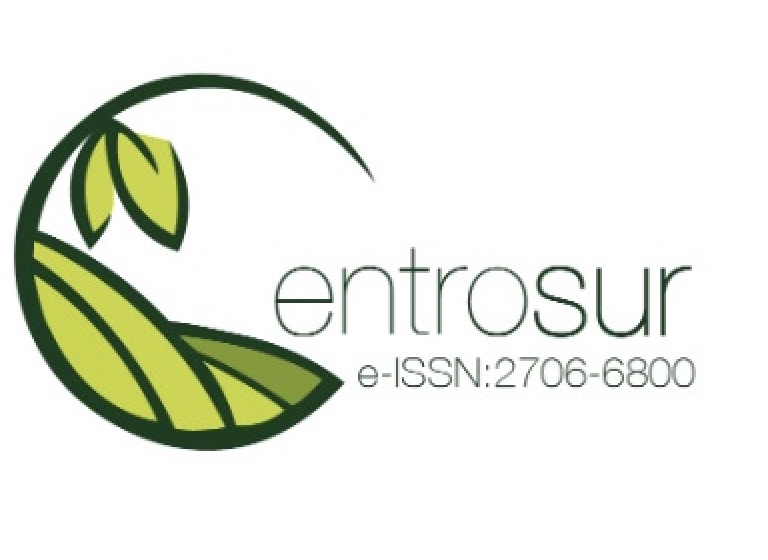
Factors that determine the quality of coffee (Coffea arabica L.) in southern Ecuador: A case study.
Centrosur, vol.. 1, no. 11, 2021
Instituto Superior Edwards Deming


Received: 11 July 2021
Accepted: 09 September 2021

Abstract: This article is derived from a master's thesis in 2019 on the influence of temperature and relative humidity of the environment on coffee quality. The study was conducted in Palanda and Vilcabamba, Ecuador, two locations with different climate and, therefore, storage conditions, in the Agroartesanal Association of Ecological Producers of Palanda and Chinchipe "APECAP", a first degree organization, formed by small producers who export high quality coffee to the American and European markets. In this work we determine the influence of the temperature and relative humidity of storage in two places with different environmental conditions on the humidity of the bean and the organoleptic quality of its infusion, determined by blind cupping. The methodology applied for this research was to identify the study area as a first step, followed by the sampling of a microplot of a five-year-old plantation. A physical and organoleptic evaluation was then carried out and the coffee density was checked by means of the cupping laboratory, and Pearson's linear correlation was applied to compare the results. The results of the study indicate that bean moisture is determined by the ambient relative humidity (RH) and mainly affects the flavor, acidity and body of the brew. The climatic conditions of both locations were studied and the quality parameters of coffee from storage were evaluated, establishing that in Vilcabamba, with a lower ambient RH, the coffee bean can be stored for up to 4 months without loss of quality, while in Palanda, with a higher RH, it can be stored for only 1 month.
Keywords: Artocarpus altilis, torrefaction, quality, feed.
Resumen: El presente artículo esta derivado de una tesis de maestría en el año 2019 sobre la influencia que tiene la temperatura y la humedad relativa del ambiente sobre la calidad del café. El estudio se realizó en Palanda y Vilcabamba, Ecuador, dos localidades con diferente Clima y, por tanto, condiciones de almacenamiento, en la Asociación Agroartesanal de Productores Ecológicos de Palanda y Chinchipe “APECAP”, una organización de primer grado, conformada por pequeños productores que exportan café de alta calidad al mercado americano y europeo. En este trabajo se determina la influencia de la temperatura y humedad relativa de almacenamiento de dos lugares con condiciones ambientales diferentes sobre la humedad del grano y la calidad organoléptica de su infusión, determinada por cata ciega. La metodología aplicada para dicha investigación se identificó el área de estudio como primer paso, seguido del muestreo de un microlote de una plantación de cinco años de edad. Luego procedió a una evaluación física y organoléptica y su posterior comprobación de la densidad del café mediante el laboratorio de catación y para cotejar los resultados se aplicó la correlación lineal de Pearson. Los resultados del estudio indican que la humedad del grano viene determinada por la humedad relativa del ambiente (HR) y afecta principalmente al sabor, la acidez y el cuerpo de la infusión. Se han estudiado las condiciones climáticas de ambas localidades y evaluado los parámetros de calidad del café procedente del almacenamiento en ellas, estableciéndose que en Vilcabamba, con una menor HR ambiente, el grano de café se puede almacenar hasta 4 meses sin pérdida de calidad, mientras que en Palanda, con mayor HR, apenas 1 mes.
Palabras clave: Almacenamiento, café pergamino, características organolépticas, humedad relativa, temperatura.
Introduction
This article is derived from a master's thesis in 2019 on the influence of temperature and relative humidity of the environment on coffee quality. The study was conducted in Palanda and Vilcabamba, Ecuador, López (2019). Therefore, as an introduction, it is important to know and understand some characteristics of coffee. The coffee plant, called coffee plant Lapoujade(2016), belongs to the order Gentianales, family Rubiaceae, tribe Coffeeae, Genus Coffea. Two species Coffea arabica and C. canephora Berselli,(2018) are cultivated from it. Of the nearly 400 described genera of the Rubiaceae family, native to South Asia and subtropical Africa, the genus coffea contains around one hundred accepted specific and intraspecific taxa.
The fruit is a drupe, of variable color during its development (green in its early stages of formation, passing through different shades of pale yellow to bright red during its maturation) and whose mesocarp forms a sweet and aromatic pulp, reddish in color, which ripens in about 35 weeks from flowering (Jure et al., 2015, p. 128). The coffee plant requires a high temperature (20 to 25°C) and high atmospheric humidity. It is a semi-shade plant, which must be protected from winds and low temperatures Quiroz-Guadarrama et al.,(2013). The coffee crop needs a relative humidity (RH) rainfall is a factor of great importance requiring, in general, an average of 1200 to 3000 mm per year to ensure production and quality (ICAFE, 2011). Arcila et al. (2007) and Kambashi et al.(2014) have extensively described its cultivation.
C. arabica, cv. 'Arabica' is grown mainly in Colombia, Peru, Central America and Brazil. It is the most cultivated species and represents between 60% and 70% of world production (CENICAFE, 2001). C. canephora, cv. Robusta, the second most abundant cultivated species, is more resistant to pests and needs less care than Arabica; it is grown mainly in Africa and Indonesia (Delgado, 1997). Ecuador is a coffee producing and exporting country and is, in turn, one of the few countries that produces the three types of coffee: washed arabica, natural arabica and robusta, and new processes are currently being implemented. The C. arabica and C. canephora species are grown in the four geographic regions (Coast, Highlands, Amazon and Galapagos Islands) (COFENAC 2012). It has a greater economic impact because it is consumed worldwide (Castañeda, 2004).
On the other hand, post-harvest coffee processing can be summarized in the production of two types of coffee, natural coffee and washed coffee, which follow two different processes. In the former, the fruit is dried directly after harvesting. Washed coffee is that which after being harvested is pulped, conserving the endosperm or parchment, fermented, washed and dried. The latter gives rise to high quality fine coffees or specialty coffees (Toscano et al., 2020, p. 228). In the coffee trade, quality refers to the physical and organoleptic characteristics that mainly affect the selling price (Fischersworring and Robkamp 2001). Specialty washed coffee accounts for approximately 10% of world production, and despite having grown in sales it is a very limited market (ICO, 2017).
The storage of quality washed coffee requires storage conditions in absolute darkness, with grain humidity between 10% - 12% (Roa et al., 1999), a RH of up to 65%, and a temperature of 19°C. The storage place should be dry, clean and well ventilated. In addition, the place should be dry, clean and well ventilated. The main factors in the quality deterioration of stored quality specialty coffees are the moisture content of the bean, temperature and RH, so that if these coffees are not kept in controlled environments their quality is quickly reminiscent of old harvest (ANACAFE, 2015). There are methods of mechanical air drying González, et al., (2010) and Nava et al.(2012), but their results are not always satisfactory.
The main problem of storage in quality coffee producing countries, even when the fruit has been properly dried, is its ability to absorb moisture from the environment, deteriorating its quality Jure et al.(2015) Stored coffee bags should be stacked on wooden pallets so that they do not come into contact with the floor or wall, in a well conditioned, ventilated and clean cellar, and in semi-darkness. Excessive light in the cellar can cause bleaching of the coffee beans (COFENAC, 2009). It is also important to highlight the organoleptic characteristics of coffee, which are the properties or qualities of the infusion that can be perceived by the senses of taste and smell. The organoleptic quality is related to the degree of satisfaction of people who consume coffee and is associated with the attributes of its infusion (Menchu, 1967a).
The genetic difference between varieties is partially responsible for the chemical composition of coffee seeds and, therefore, their quality. This makes C. arabica the best quality species. In Ecuador, the largest production is of this species and two "original" cvs. have always been cultivated: 'Tipica' ('Criolla' or 'Silvestre') and 'Bourbon'; but also widely cultivated are the cvs. 'Caturra' (a mutation of 'Bourbon'), 'Pache' (mutation of 'Típica'), 'Catimor' (hybrid of 'Caturra' and the hybrid 'Timor'), and to a lesser extent 'Mundo novo' (hybrid of 'Bourbon' x 'Sumatra') and 'Catuaí' (hybrid of 'Caturra' x 'Mundo novo').
The quality of a coffee infusion is determined firstly by the physical characteristics of the bean, and then by the organoleptic characteristics. Therefore, the determination of the quality of coffee is nothing more than the qualification of its physical and organoleptic characteristics and is based on the demands of the consumer (Castañeda, 2004).
These are also determined to a great extent by the result of a set of processes that allow the expression, development and conservation of the physical-chemical characteristics of the product, from its production to the moment of its transformation or consumption. Almost all of the specialty coffee produced in Ecuador is exported and the international market functions based on the concept of commercial quality, in such a way that its characteristics have been established by roasters and producers according to the availability and price of the different types of green coffee.
In order to carry out the organoleptic evaluation and determine the quality of the coffee the following parameters are evaluated: fragrance/aroma, flavor, residual flavor, acidity, body, uniformity, balance, clean cup, sweetness, and the cupper's score. The average of these 10 evaluated parameters results in the cupping value of the coffee. In this study the effect of storage temperature and RH on the 10 descriptor attributes of the quality of washed export coffee evaluated by cupping in two collection centers, Palanda and Vilcabamba, in Ecuador, during the months of harvest (July, August and September) was determined. During this period, the evolution of bean humidity and the organoleptic quality of the infusion were monitored in order to establish the best storage conditions to optimize its commercialization.
Materials and methods
The study was conducted in the Province of Zamora Chinchipe, in the canton Palanda, at 1098 masl, coordinates 17M0706972, UTM 9486264, and in the province of Loja, in the Parish Vilcabamba, at 1577 masl, coordinates 17M0697225, UTM 9528727, between the months of June to October 2017. The physical and organoleptic characterization of parchment and roasted coffee was carried out in the quality control laboratory of the Association of Ecological Producers of Specialty Coffees of Loja Canton (APECAEL), located in the Parish of San Pedro de Vilcabamba.
The samples used came from a microlot of 6 quintals of 100 lb. of washed parchment coffee of C. arabica L., cv. Catimor, 5 years old, from the Association of Ecological Producers of Palanda and Chinchipe, from the 2017 harvest. The plantation is located in Barrio Agua Dulce Bajo del Cantón Palanda, at 1233 masl, 70% slope, soil pH of 6.3 and with an area of 0.33 ha. The 6 lots of 100 pounds of washed parchment coffee each were weighed and bagged in 6 jute bags for storage. Three of the six bags, chosen at random, were stored in the APECAP warehouse in Palanda, at 1098 masl, and the other three in a warehouse in Parroquia Vilcabamba, at 1577 masl. The bags were placed on a wooden pallet to avoid direct contact with the ground and 40 cm from the wall. A hygrometer thermometer (Gizga, model KT-907, China) was installed at each site to record daily grain temperature and humidity at 10 am and 3 pm. Data were recorded for 99 days from July 6 to October 12, 2017.
Nine physical and organoleptic evaluations were carried out throughout the study period to determine the degree of acceptance of the coffee (Table 1). In each evaluation two tasters each made 1 cupping. As an initial sample a 1 kg sample was extracted from the entire microlot of coffee, and on the following 8 evaluations (days 1, 8, 15, 22, 22, 36, 36, 50, 50, 64, 78, and 99) ½ kg was extracted from the bags stored in Palanda and Vilcabamba, the samples were prepared separately, and the evaluations were carried out in blind cupping. For this purpose, the following protocol was followed:
1) Threshing: the parchment was removed from 300 g of coffee with a laboratory threshing machine; 2) Humidity control: periodically the humidity of the green coffee beans was determined with a portable laboratory bean humidity measuring equipment (G-600); 3) Counting of defects: the physical characteristics of the coffee were determined according to the requirements of the Peruvian Technical Norm for coffee (NTP 209.310-2008), and for parchment coffee and green coffee (NTP-209.027-2001 and by NTP- ISO 10470-1998); 4) Roasting: 100 g of the stored coffee samples were roasted in a Probat laboratory coffee roasting machine, model PRG1 Z, manufacturer Probat Werke, Germany, controlling the roasting temperature for the efficient organoleptic evaluation at 195°C, with a time of 8 to 12 min for each roasting; 5) Grinding: after at least 8 hours of roasting, the coffee was ground, by separate samples for each cup, until its granulation; 6) Organoleptic evaluation of coffee: for the sensory evaluation, the coffee cupping protocol of the Specialty Coffee Association of America (SCAA) was followed, a process of sensory evaluation or cupping of an infusion of coffee in a 200 ml. pyrex cup, starting with 11 g of roasted ground coffee, boiled with 200 ml. of water, boiled with 200 ml of natural water for each sample, and from which the roast is evaluated first and then the fragrance/aroma, flavor, residual flavor, acidity, body, sweetness, balance, clean cup, uniformity, and the cupper's score, describing the characteristics of the coffee. After the determination of these coffee attributes, the organoleptic evaluation of the coffee was determined according to the SCAA grading scale (Table 1).

The density of coffee beans is determined in the cupping laboratory. One method to determine the density of coffee is to evaluate the weight of green coffee contained in 1 liter. When it has more than 650 g l-1, it is classified as a high density coffee. In general, a fresh coffee from high altitude zones has a denser bean structure than old coffees or coffees from low altitude zones (COFENAC, 2004).
Pearson's linear correlation was applied to the results, whose correlation coefficient is an indicative value of the relationship between two quantitative variables. The correlation coefficient between two random variables x and y is the quotient: ; where sis the standard deviation of each variable.
Result
The final coffee score, or cupping value, is negatively and significantly related to bean moisture (Figure 1). According to our results, with a bean humidity between 9 and 11.5% the best scores are obtained for coffee, while for higher values its quality deteriorates. However, in the coffee trade, if the humidity of the bean drops below 10.5% its quality and with it the price, but if it maintains a score above 80 points, it can still be marketed as a specialty coffee. This is due to the fact that this decrease in bean moisture generates a loss in bean weight that will be reflected in the total weight of the coffee lot, with the consequent economic losses due to drying of the bean. ANACAFE (2015) indicates that the main factors in the deterioration of the quality of coffee are the humidity of the bean and the relative humidity, which if the coffee is not kept in a controlled environment it will begin to lose its attributes.
Coffee quality
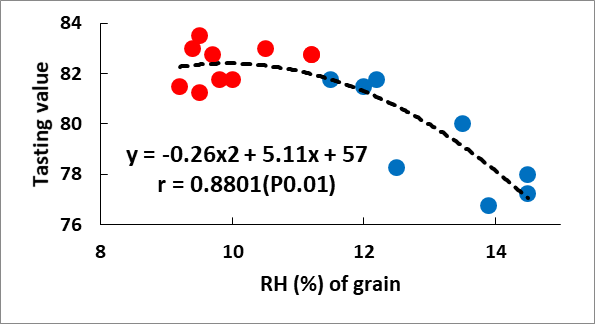
Evolution of coffee quality
The quality of the coffee stored during the months of July to October decreased over time, both in Palanda and Vilcabamba (Figure 2). Taking 80 as the limit value for cupping of specialty coffee (see apt. 4.1), in Vilcabamba the quality of the coffee always remained above it and could be traded on the international market, while that stored in Palanda deteriorated more rapidly and in 1 month reached a value below 80 points, reaching values of 76.7 in October, which indicates that this coffee does not meet the requirements of international markets and, therefore, its commercialization will be on the local market.
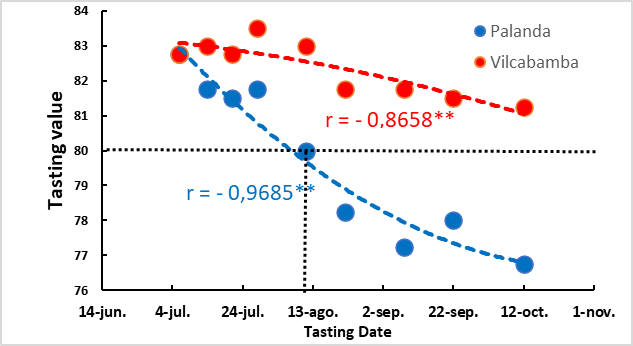
According to Jure et al.(2015) and Alvarado and Puerta (2002), the deterioration of coffee quality is due to climatic conditions of storage, temperature and ambient RH, which influence the increase in bean humidity, very important factors to consider in the collection of high quality coffees for demanding markets.
Climatic factors of the environment of Palanda and Vilcabamba.
According to the Köppen-Geiger climate classification, the climate in Palanda is Tropical Forest. During the months in which most of the quality coffee is harvested, from July to October, the average monthly rainfall was 72.5 mm, and the average temperature was 22.5 °C. Both values resulted in an ambient RH of 65% - 70% (PD and OT of Cantón Palanda, 2010), which is high for quality coffee.
· Climatic characteristics of Palanda
It is worth noting, on the one hand, the practically constant temperature during the collection and storage period (July - October) and its thermal amplitude in those months (± 1º C) (Table 3), and, on the other hand, the stable monthly precipitation during the same period (± 3.5 mm).

· Climatic characteristics of Vilcabamba
The climate in Vilcabamba is, according to the Köppen-Geiger classification, Savana Tropical. The average rainfall in the months of harvest, July to October, was 26 mm, taking into account that in July and August barely exceeded 8 mm per month, and the average temperature was 20.8°C. Accordingly, the RH of the environment barely reaches 60%, markedly lower than that of Palanda.
Also here, temperature was practically constant during the collection and storage period (July - October) as well as its thermal amplitude in those months (± 1.5º C) (Table 3), but monthly precipitation increasing with the months (± 10.0 mm) was not (± 10.0 mm).

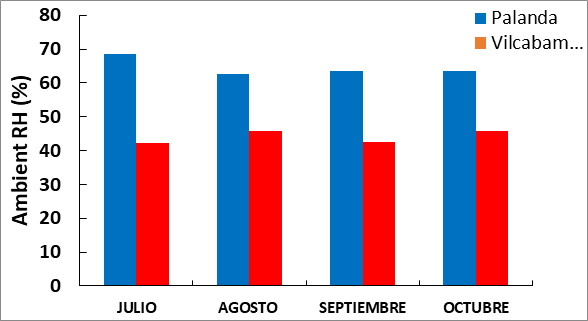
The result of all this is a markedly higher RH in Palanda throughout the months of storage (Figure 3). In Vilcabamba it ranged from 42.25 to 45.89 %.
Evolution of coffee bean humidity. Influence of environmental conditions
The ambient RH and precipitation conditions of the two coffee storage sites are, therefore, markedly different, and only the average temperature of both sites presents similar values, 22.3 ± 0.4º C in Palanda and 20.5 ± 0.3º C in Vilcabamba. The big difference, therefore, is in the precipitation, much higher in Palanda, which explains its higher ambient RH values. This has a direct influence on the RH of the storage center and, consequently, on grain moisture (Figure 5). Indeed, in our experiment, in the Vilcabamba warehouse, storage RH ranged from 35% to 49.5% and grain moisture from 9.2% to 11.2%, while in Palanda it was 53% to 74% and 11.2 to 14.5%, respectively (Figure 5). This positive correlation between ambient RH and bean moisture therefore determines the suitability of the storage area. Thus, in Palanda, where the ambient RH is higher, so is the storage RH and that of the coffee bean, which causes a more rapid deterioration of its quality in this locality (Figure 2). In the case of Vilcabamba, the low rainfall generates a lower relative humidity, which prevents the coffee bean from increasing its humidity. CENICAFE (2006), states that coffee with a moisture content of between 10% and 12% can be kept for up to 10 months in good storage conditions with a relative humidity of 65% to 70%; however, the temperature and relative humidity of the environment must be taken into account.
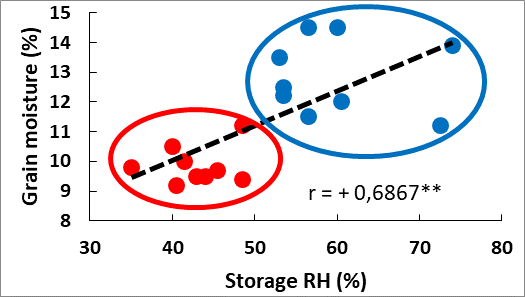
Qualification of coffee quality parameters. Influence of storage relative humidity
According to the results presented, an increase in storage RH causes an increase in coffee bean moisture (Figure 5) and this, in turn, is negatively related to the cupping value (Figure 1), that is, to coffee quality. It is not surprising, therefore, that the storage RH is negatively related to the cupping value.
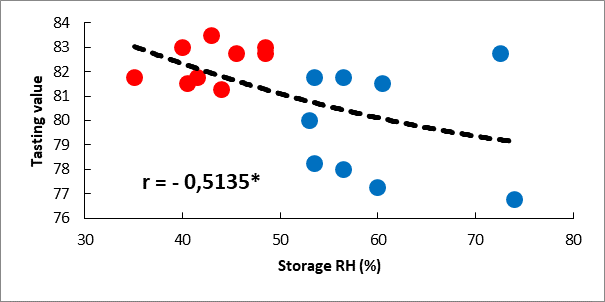
Accordingly, and in correspondence with the lower RH of storage in Vilcabamba, the coffee stored in this locality will develop a superior quality (Figure 6). This is a consequence of the negative relationship between the RH of storage and most of the 10 attributes or quality parameters that make up the cupping, which is in agreement with the criteria of Fischersworring and Robkamp (2001). This is generally the case, but only fragrance and aroma correlate significantly with storage RH. Residual flavor and balance approach statistical significance, and acidity, body, uniformity, clean cup and sweetness are independent of RH.
Qualification of coffee quality parameters. Influence of bean humidity.
The relationship between storage RH and coffee quality is, however, of little value since the evolution of ambient RH during the months of harvesting and storage was not the same in both locations. Thus, in Palanda it increased over time, while in Vilcabamba it decreased slightly. And this is crucial in the interpretation of the results. In fact, in the latter locality, the loss of water in the coffee bean caused a certain drying, slightly deteriorating its quality, although it remained special until the end of the evaluation, while in Palanda it was the increase in RH that deteriorated its quality until it lost its commercial value.
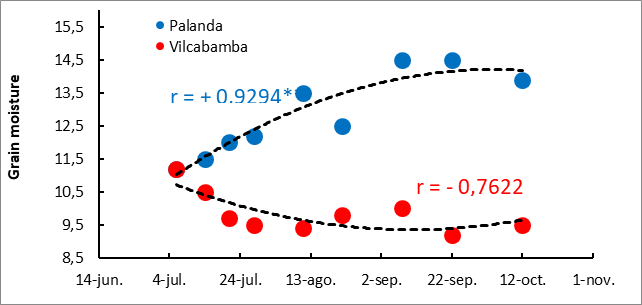
This is the reason why the tasting value for Vilcabamba increased, albeit slightly, with grain moisture up to a value of 11.2% (Figure 8). That is, in this range, an increase in grain moisture means an increase in its water content, which prevents it from drying out and thus improves its quality. However, from this value of bean humidity, the increase acquired in Palanda caused a decrease significantly correlated with the cupping value to values below 80 (Figure 8), the minimum value required for its commercialization as an excellent quality coffee (Table 2).
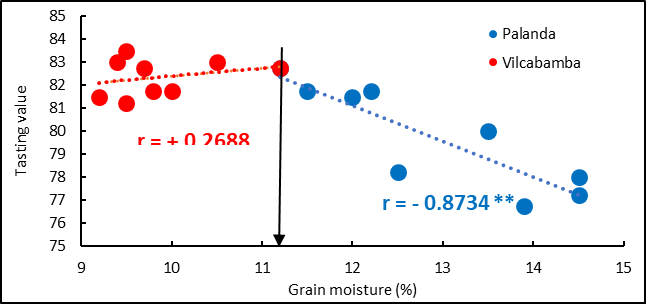
It can be concluded, therefore, that a value around 11 (11.2 in our experiment) is the grain moisture threshold that marks the optimum tasting value (84 in our experiment; Table 2). These results coincide with those of Roa et al. (1999) and CENICAFE (2006), which establish a range of 10% - 12% bean moisture as the optimum for conservation to maintain optimum quality. And this value is the one that marks, in turn, the changes in the quality parameters evaluated, particularly in flavor, acidity and body, for which bean moisture and the parameter evaluated correlate significantly in both storage locations and with the slopes in correspondence with the temporal evolution of bean moisture. Uniformity, clean cup and sweetness are independent of bean moisture.
Qualification of coffee quality parameters. Influence of storage location.
In both locations, the temporal evolution of coffee attributes follows a similar pattern to that conditioned by bean moisture. Thus, in Palanda the attributes highly affected are fragrance/aroma, flavor, residual flavor, acidity, body, balance and cupper's score, as occurred when they were determined as a function of bean moisture, while in Vilcabamba the attributes highly affected are the, body and cupper's score.
This indicates the unfavorable conditions in Palanda for preserving coffee, since all of the attributes that depend on the humidity of the bean degrade at a faster rate than in Vilcabamba. Moreover, in Vilcabamba only two attributes are negatively affected, and to a lesser extent than in Palanda.
This behavior allows in Vilcabamba to conserve the quality of specialty coffee in optimum conditions for a period of time of at least 4 months (from July 6 to October 12 in our experiment), taking 80 as the minimum acceptable cupping value (Figure 2). In Palanda, however, the storage time was dramatically reduced, reaching values below 80 after 1 month of storage (from July 6 to August 11 in our experiment; Figure 4).

In addition to the quality parameters analyzed, coffee bean density is also altered by storage conditions. The reference value for this attribute is set at 650 g l-1, so that higher values are more appreciated.
The coffee stored in both locations far exceeded this value, but that of Vilcabamba exceeded 730 g l-1, while that of Palanda barely exceeded 700 g l-1 (Table 5). This higher density of the Vilcabamba coffee is logical given the lower humidity of the beans in this storage location (Figure 5). Likewise, the better quality attributes achieved in Vilcabamba are related to the higher density of the coffee stored in this location, showing density as a valid indirect evaluation to determine the quality of the coffee bean.
Conclusions
Coffee quality is determined by the humidity of the stored beans. Bean moisture is significantly correlated with ambient RH. The quality attributes most affected by bean moisture are flavor, acidity and body. Fragrance/aroma, residual flavor, balance, and cupper's score are affected to a lesser extent. Uniformity, clean cup and sweetness are independent of bean moisture. According to the conditions of our experiment in the locality of Vilcabamba, with a lower ambient RH (42% - 46%), the coffee bean can be stored for up to 4 months without loss of quality, taking 80 as the reference cupping value. In Palanda, with a higher RH (63.5% - 68.5%) it can only be stored for 1 month. The optimum humidity of the bean is established between 11 and 12%, although this determination is indirect.
References
Alvarado, G., & Puerta, G. I. (2002). The Colombia variety and its physical and cup quality characteristics. Cenicafe(303), 1-4. https://www.cenicafe.org/es/index.php/nuestras_publicaciones/avances_tecnicos/avance_tecnico_0303
ANACAFE. (June 1, 2015). ANACAFE (2015). National Coffee Association. Guía de factores que inciden en la calidad del café. Una alternativa para hacer el cafetal sostenible. https://docplayer.es/42798037-Guia-de-factores-que-inciden-en-la-calidad-del-cafe-una-alternativa-para-hacer-el-cafetal-sostenible.html
Arcila, J., Valencia, F., Berrocal, A., Salazar , L., & Incapie, E. (2007). Coffee production systems in Colombia. Colombia: FNC Cenicafé. https://biblioteca.cenicafe.org/bitstream/10778/720/1/Sistemas%20producci%C3%B3n%20caf%C3%A9%20Colombia.pdf
Berselli, C. (2018). Distribution channels and strategies in restaurants A study in Balneário Camboriú - Brazil. Estudios y Perspectivas En Turismo, 27(3), 609-627. http://www.scielo.org.ar/pdf/eypt/v27n3/v27n3a07.pdf
Castañeda, E. (2004). Potential Bases "Of the Diversified and Environmentally Friendly Coffee Farm. Lima: TECNATROP SRL.
COFENAC. (2004). National Coffee Council. Physical and organoleptic characterization of arabica coffees in the main agro-ecosystems of Ecuador. Portoviejo-Ecuador: Impregcol cia ltda.
Delgado, C. (1997). El libro del café. Madrid: Alianza Editorial.
Fischersworring, B., & RoBkamp, R. (2001). Guide for ecological coffee growing. Tapachula.
González, C., Sanz, J., & Oliveros, C. (2010). Air flow and temperature control in mechanical coffee drying. Cenicafé, 61(4), 281-296.
ICAFE. (2011). Technical Guide for Coffee Cultivation. Costa Rica: Heredia.
Jure, M. A., Condorí, M. S., Terrazzino, G. P., Catalán, M. G., Campo, A. L., Zolezzi, G., Chinen, I., Rivas, M., & Castillo, M. (2015). Isolation and characterization of Escherichia coli O157 in bovine meat products and half-carcasses in the province of Tucumán. Revista Argentina de Microbiologia, 47(2), 125-131. https://doi.org/10.1016/j.ram.2015.03.006.
Kambashi, B., Boudry, C., Picron, P., & Bindelle, J. (2014). Forage plants as an alternative feed resource for sustainable pig production in the tropics: A review. Animal, 8(8), 1298-1311. https://doi.org/10.1017/S1751731114000561
Lapoujade, A. L. (2016). Healthy diet, pure food and purification in the Greco-Latin world. Nova Tellus, 34, 109-121. http://www.redalyc.org/pdf/591/59146029007.pdf.
López, E. (2019). Influence of storage temperature and relative humidity on coffee (Coffea arabica L.) quality (Master's thesis). Valencia: Universitat Politècnica de València. Departamento de Producción Vegetal - Departament de Producció Vegetal. https://riunet.upv.es/handle/10251/129921
Nava, E., García, C., Camacho, R., Báez, E., & Montoya, R. X. (2012). Biopesticides: An Option for the Biological Pest Control Biopesticides: an Option for the Biological Pest Control. Ra Ximhai, 8(3), 17-29.
Quiroz-Guadarrama, C. D., Rojano-Rodríguez, M., Herrera-Esquivel, J. J., de la Concha-Bermejillo, F., Romero-Loera, L. S., Estrada-Moscoso, I., del Rio-Suarez, I., Morales-Vargas, J. M., Torres-Ruiz, M. F., Gonzalez-Angulo, J. A., Beristain-Hernandez, J. L., Alonso-Lárraga, J., Cárdenas-Lailson, E., & Moreno-Portillo, M. (2013). Peroral endoscopic full- and partial-thickness myotomy. A viability study in an animal model. Revista de Gastroenterología de México (English Edition), 78(4), 225-230. https://doi.org/10.1016/j.rgmxen.2014.02.005.
Toscano, A. R., Piñeres Castillo, A. P., Mojica Herazo, J. C., López, R. L., & Restrepo, R. R. (2020). Management and control of variables for the generation of biogas from pig zungo. Procedia Computer Science, 177, 261-266. https://doi.org/10.1016/j.procs.2020.10.036.

